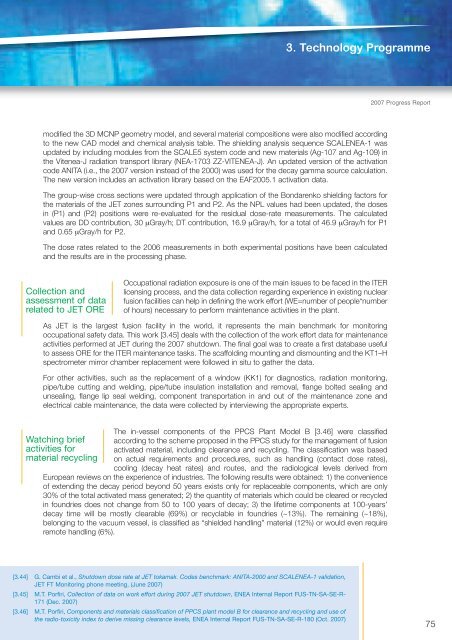Fusion Programme - ENEA - Fusione
Fusion Programme - ENEA - Fusione
Fusion Programme - ENEA - Fusione
- No tags were found...
You also want an ePaper? Increase the reach of your titles
YUMPU automatically turns print PDFs into web optimized ePapers that Google loves.
3. Technology <strong>Programme</strong>2007 Progress Reportmodified the 3D MCNP geometry model, and several material compositions were also modified accordingto the new CAD model and chemical analysis table. The shielding analysis sequence SCAL<strong>ENEA</strong>-1 wasupdated by including modules from the SCALE5 system code and new materials (Ag-107 and Ag-109) inthe Vitenea-J radiation transport library (NEA-1703 ZZ-VIT<strong>ENEA</strong>-J). An updated version of the activationcode ANITA (i.e., the 2007 version instead of the 2000) was used for the decay gamma source calculation.The new version includes an activation library based on the EAF2005.1 activation data.The group-wise cross sections were updated through application of the Bondarenko shielding factors forthe materials of the JET zones surrounding P1 and P2. As the NPL values had been updated, the dosesin (P1) and (P2) positions were re-evaluated for the residual dose-rate measurements. The calculatedvalues are DD contribution, 30 μGray/h; DT contribution, 16.9 μGray/h, for a total of 46.9 μGray/h for P1and 0.65 μGray/h for P2.The dose rates related to the 2006 measurements in both experimental positions have been calculatedand the results are in the processing phase.Collection andassessment of datarelated to JET OREOccupational radiation exposure is one of the main issues to be faced in the ITERlicensing process, and the data collection regarding experience in existing nuclearfusion facilities can help in defining the work effort (WE=number of people*numberof hours) necessary to perform maintenance activities in the plant.As JET is the largest fusion facility in the world, it represents the main benchmark for monitoringoccupational safety data. This work [3.45] deals with the collection of the work effort data for maintenanceactivities performed at JET during the 2007 shutdown. The final goal was to create a first database usefulto assess ORE for the ITER maintenance tasks. The scaffolding mounting and dismounting and the KT1–Hspectrometer mirror chamber replacement were followed in situ to gather the data.For other activities, such as the replacement of a window (KK1) for diagnostics, radiation monitoring,pipe/tube cutting and welding, pipe/tube insulation installation and removal, flange bolted sealing andunsealing, flange lip seal welding, component transportation in and out of the maintenance zone andelectrical cable maintenance, the data were collected by interviewing the appropriate experts.The in-vessel components of the PPCS Plant Model B [3.46] were classifiedWatching brief according to the scheme proposed in the PPCS study for the management of fusionactivities foractivated material, including clearance and recycling. The classification was basedmaterial recycling on actual requirements and procedures, such as handling (contact dose rates),cooling (decay heat rates) and routes, and the radiological levels derived fromEuropean reviews on the experience of industries. The following results were obtained: 1) the convenienceof extending the decay period beyond 50 years exists only for replaceable components, which are only30% of the total activated mass generated; 2) the quantity of materials which could be cleared or recycledin foundries does not change from 50 to 100 years of decay; 3) the lifetime components at 100-years’decay time will be mostly clearable (69%) or recyclable in foundries (~13%). The remaining (~18%),belonging to the vacuum vessel, is classified as “shielded handling” material (12%) or would even requireremote handling (6%).[3.44] G. Cambi et al., Shutdown dose rate at JET tokamak. Codes benchmark: ANITA-2000 and SCAL<strong>ENEA</strong>-1 validation,JET FT Monitoring phone meeting, (June 2007)[3.45] M.T. Porfiri, Collection of data on work effort during 2007 JET shutdown, <strong>ENEA</strong> Internal Report FUS-TN-SA-SE-R-171 (Dec. 2007)[3.46] M.T. Porfiri, Components and materials classification of PPCS plant model B for clearance and recycling and use ofthe radio-toxicity index to derive missing clearance levels, <strong>ENEA</strong> Internal Report FUS-TN-SA-SE-R-180 (Oct. 2007)75













